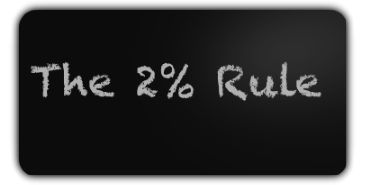Risk Management: The 2 Percent Rule
The 2 percent rule is a fundamental precept of risk management (I incline toward the expressions "risk management" or "capital protection" as they are more engaging than "money management"). Regardless of the fact that the chances are stacked to favor you, it is imprudent to risk a vast amount of your capital on a solitary trade.
Mr. Larry Hite, in Jack Schwager's Market Wizards (1989), notice two lessons gained from a companion:
- Don't bet your way of life - never chance an extensive piece of your capital on a solitary trade; and
- Always recognize what the worst result is.
Hite goes on depict his 1 percent rule which he applies to an extensive variety of business sectors. This has subsequent to been adjusted by traders and brokers as the 2 percent rule:
The 2 Percent Rule: "Never risk your money more than 2 percent of your whole capital on only one stock."
This implies that 10 consecutive losses would only consume 20% of your capital. It doesn't imply that you have to trade 50 different stocks - your capital at danger is typically far not exactly the price of the stock.
Applying the 2 Percent Rule:
1. Compute 2% of your trading capital: your Capital at Risk
2. Deduct the brokerage fee during buy and sell to go at your Maximum Permissible Risk
3. Compute your Risk per Share:
Deduct your stop-loss from the buy price and add an arrangement for slippage (not all stops are executed at as far as possible). For a short trade, the methodology is reversed: deduct the buy price from the stop-loss before adding slippage.
4. The Maximum Number of Shares is then computed by dividing your Maximum Permissible Risk by the Risk per Share.
EXAMPLE #1:
Think that your total trading capital is 20,000 pesos and your brokerage fees are fixed at 50 pesos per one trade.
1. Your Capital at Risk is: 20,000 pesos * 2 % = 400 pesos per trade.
2. Deduct brokerage fee, on the buy and sell, and your Maximum Permissible Risk is: 400 pesos - (2 * 50 pesos) = 300 pesos.
3. Compute your Risk per Share:
If the price of a stock is estimated at 10.00 pesos and you need to put a stop-loss at 9.50 pesos, then your risk is 50 cents per share.
Add slippage of say 25 cents and your Risk per Share increments to 75 cents per share.
4. The Maximum Number of Shares that you can buy is:
300 pesos / 0.75 cents = 400 shares (at an expense of 4000 pesos)
EXAMPLE #2
Your capital is $20,000 and brokerage fee is lessened to $20 per trade. What number of shares of $10.00 would you be able to buy if you have stop-loss at $9.25?
Apply the 2 percent rule.
NOTE: Remember to take for a brokerage fee, on the buy and sell, and slippage (of say 25 cents/share).
Answer: 360 shares (at an expense of $3600).
Capital at Risk: $20,000 * 2 percent = $400
Deduct brokerage fee: $400 - (2 * $20) = $360
Risk per Share = $10.00 - $9.25 + $0.25 slippage = $1.00 per offer
Most Number of Shares = $360/$1 = 360 shares
Summary:
A general rule for stock or currency markets is to never risk more than 2 percent of your capital on any one stock. This guideline may not be appropriate for long-term traders who appreciate higher risk reward proportions yet bring down success rates. The guideline ought to likewise not be applied in isolation: your greatest risk is the market risk where most stocks move as one. To ensure against this we ought to restrain our capital at risk in any one area furthermore our capital at risk in the whole market at any one time.


No comments:
Post a Comment